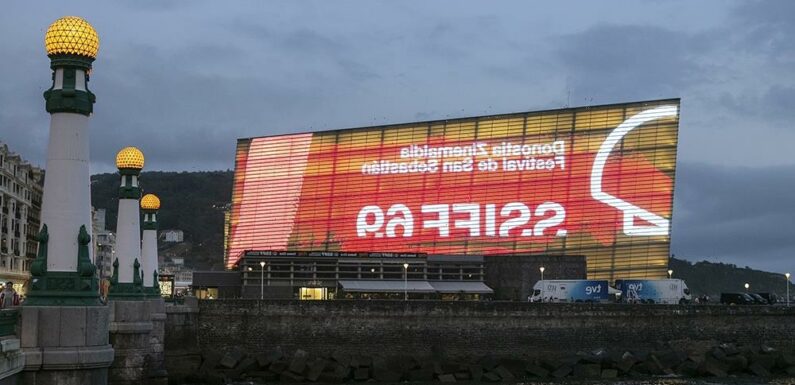
The dream child of 10 Basque businessmen who hoped to prolong San Sebastián’s summer season into late September, the San Sebastian Film Festival was born on Sept. 21, 1953.
Presented by bullfighter Mario Cabré, who romanced Ava Gardner, and comprising just 19 films, won by “La guerra de Dios,” directed by Rafael Gil., rescued from a potential Republican firing squad by Luis Buñuel not so many years before. Fireworks, bullfights and quayside parties regaled the film week.
From that first edition remain the beauty and gastronomy of San Sebastian, a Belle Epoque resort boasting the spectacular white-sand Concha Bay, steep-backed hills, an old quarter of higgeldy-piggeldy streets and a trio of three-star Michelin restaurants. 70 years later, San Sebastián still stuns.
For its first 20 years, held under dictator Francisco Franco, San Sebastián proved, however, a window onto a freer world for a privileged elite, a window onto a freer world graced by Federico Fellini, presenting “Nights of Cabiria” (1957), Alfred Hitchcock who came for “Vertigo” (1958) and a still young Francis Ford Coppola, whose “Rain People” won its 1969 Golden Shell.
The modern festival’s foundations were first laid by Spain’s ‘70s transition from dictatorship to democracy. “Previously banned filmed are screened. The festival begins to connect to new times,” says Jose Luis Rebordinos, San Sebastian’s current director.
Victor Erice’s “Spirit of the Beehive” and José Luis Borau’s “Furtivos,” two great Spanish films condemning the society Franco created, won San Sebastian’s Gold Shell in 1973 and 1975, as the festival becomes a platform for protest, by both democrats and Basque separatists.
Those turbulent times are gone. Top-notch Spanish social-issue arthouse pushing the envelope on inclusion, justice and now reconciliation still gravitates towards San Sebastian. Distances apart, this year’s “Prison 77” and Isabel Coixet’s “The Yellow Ceiling,” a gender abuse doc-feature, are heirs to that protest tradition.
Another before-and-after was the appointment in 1986 of El País film critic Diego Galán as festival artistic director. Galán inaugurates the Donostia Award for Hollywood stars, big-screen sessions at San Sebastian’s near 3,000-seat Velodrome,
including one for “Salvador” which marvelled a young Oliver Stone, and slogans such as “Everybody to the cinema.”
“Such phrases might seem simplistic, but at the time they were mind-boggling: Somebody telling San Sebastian’s citizens that the festival was ours when we’d thought it was only for a rich elite, Diego popularised the festival,” Rebordinos recalls.
Abetted by Manuel Pérez Estremera, a future festival director and then TVE exec, Galán turns San Sebastian into Europe’s first big festival to reach out boldly to Latin America, screening five features from the region in its main Zabaltegi sidebar in 1987.
Galan’s biggest achievement, at least by his own estimation, may have been persuading Bette Davis to come to San Sebastian to receive a Donostia Award. At a press conference, she fielded question with a near regal good grace. It was Davis’ last great performance: She died in Paris four days later.
Working more quietly behind the scenes, former EiTB Basque pubcaster exec Mikel Olaciregui, fest director over 2001-10, forged many more of today’s fest hallmarks. “It’s Mikel who goes to Los Angeles ever year, establishes contact with all the industry and really begins to put the festival on the international map,” Rebordinos observes.
Olaciregui also persuades Spanish producers to screen films at San Sebastian en mass. For three decades, its FIAPF A” category pulled in 1956, 1963 and 1980-84, San Sebastian wavered between its status as a general festival and becoming a specialised event. It strong emphasis on Latin America and Spain allows it be both.
From 2011, Rebordinos has doubled down on industry, launching an Europe-Latin America Co-Production Forum and now a Creative Investors’ Conference. Industry attendance has more than tripled to 1,800 delegates since 2011, he notes.
Once a 10-day event, San Sebastian now forms part of a fertile film-TV axis in the city with culture center Tabakalera and the Basque Film Archive, which launched the Ikusmira Berriak incubator in 2015 and Elias Querejeta Zine Eskola two years later. Cannes Directors Fortnight title “The Water,” and “Suro” and “Pornomelancholy,” both in San Sebastian 2022 competition, were all developed at Ikusimira Berriak.
Celebrating its 70th edition, San Sebastian now stands in a spectacular place, and not only for its setting: an ally of Cannes in the pandemic and at Ventana Sur; the most signifiant film festival in the Spanish-speaking world; Spain’s most important cultural event, according to annual polls; part of a vibrant year-round film-TV axis in San Sebastian; and one pillar of Spain’s $1.6 billion Spain AVS Plan.
The big question, as Rebordinos acknowledges, is not, as under Franco, whether San Sebastian survives, but how it can grow even more in the future.
Read More About:
Source: Read Full Article